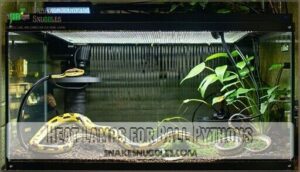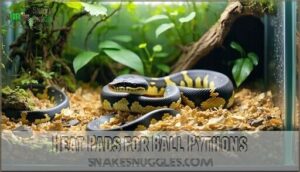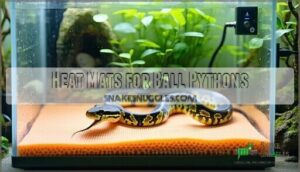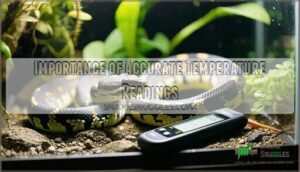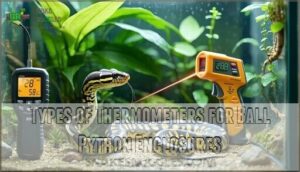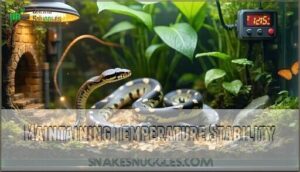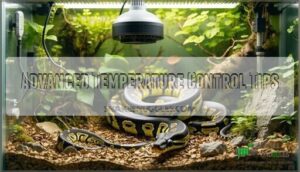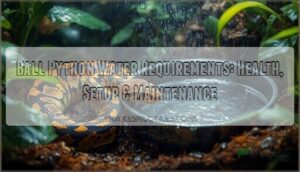This site is supported by our readers. We may earn a commission, at no cost to you, if you purchase through links.
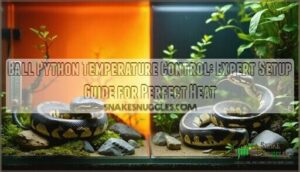
Use under-tank heaters or ceramic heat emitters paired with thermostats to maintain consistent temperatures. Place digital thermometers on both sides to monitor conditions accurately.
Nighttime temps can drop to 75-78°F safely. Proper temperature gradients help your python thermoregulate naturally, supporting healthy digestion and behavior.
Without correct heating, your snake can’t properly digest food or fight off illness. Getting the basics right prevents most health issues, but there’s more to creating the perfect thermal environment than just hitting target numbers.
Table Of Contents
- Key Takeaways
- Ball Python Temperature Needs
- Heating Options Compared
- Thermometer Placement Guide
- Maintaining Temperature Stability
- Advanced Temperature Control Tips
- Frequently Asked Questions (FAQs)
- Can you leave a heat lamp on 24/7 for ball python?
- What is the best heating option for a ball python?
- Where should I put my thermometer in my ball python tank?
- What happens if ball python gets too cold?
- Can ball pythons survive power outages overnight?
- Do ball pythons need nighttime temperature drops?
- How often should heating equipment be replaced?
- What temperature kills ball python parasites safely?
- Conclusion
Key Takeaways
- You’ll need precise temperature zones – maintain 88-92°F on the warm side and 78-80°F on the cool side to create the thermal gradient your ball python needs for proper thermoregulation and digestion.
- Digital thermometers and thermostats aren’t optional – place thermometers at substrate level on both sides of the enclosure and use quality thermostats to prevent dangerous temperature fluctuations that can harm your snake.
- Combine heat sources for best results – use under-tank heaters as your primary base heat with ceramic heat emitters or heat lamps to eliminate cold spots and maintain consistent temperatures throughout the enclosure.
- Nighttime drops are natural and healthy – let temperatures drop to 75-78°F at night to mimic your python’s natural habitat patterns while supporting healthy behavior and feeding responses.
Ball Python Temperature Needs
Your ball python needs precise temperature control to stay healthy and digest food properly. Creating the right thermal environment means establishing specific temperature zones that mimic their natural habitat conditions.
Ideal Temperature Range for Ball Pythons
Your ball python needs a basking temperature of 88-92°F and a cool side around 78-80°F.
Night temperatures can drop to 75-78°F safely.
Hatchling temperatures should match adult requirements, though young pythons need closer monitoring.
This temperature gradient lets your python thermoregulate naturally, moving between warm and cool areas as needed for ideal health and digestion.
Temperature Gradients in The Enclosure
Creating the right temperature gradient in your ball python’s enclosure mimics their natural behavior in the wild.
You’ll need a basking spot at 88-92°F and a cool side around 78-80°F.
This thermal gradient lets your snake regulate body temperature by moving between zones.
Size matters – larger enclosures need more heating elements to maintain proper gradients.
Use digital thermometers on both sides to measure gradients accurately.
A proper setup also requires careful heat source selection.
Seasonal variation isn’t necessary for captive pythons, and a well-designed enclosure will provide the necessary thermal environment for your pet.
Importance of Temperature Control for Ball Pythons
Temperature control acts as your ball python’s lifeline. Without proper ball python temperature and ideal python temperature ranges, your snake faces serious health risks.
Poor temperature control triggers devastating metabolic impact, leading to sluggish digestion and weakened immune function. You’ll notice behavioral changes like excessive hiding or refusing food.
Digestive health suffers dramatically in cold environments, while shedding success depends entirely on consistent python temperature gradient and snake enclosure heat management.
Heating Options Compared
You’ll need to choose between three main heating methods to keep your ball python comfortable: heat lamps, heat pads, and heat mats.
Each option has distinct advantages and works best in specific situations, so understanding their differences will help you create the perfect thermal environment for your snake.
Heat Lamps for Ball Pythons
When setting up your ball python’s habitat, heat lamps offer superior temperature control compared to other reptile heat sources.
They create natural basking spots that encourage proper Python Behavior while distributing warmth throughout the enclosure.
Consider these essential Lamp Types for maximal Heat Distribution:
- Ceramic heat emitters – provide consistent heat without disrupting Lighting Cycles
- Halogen bulbs – deliver focused basking heat during daylight hours
- Infrared projectors – penetrate deeper for tissue-warming benefits
Always prioritize Lamp Safety with thermostats and guards to prevent burns while maintaining your ball python temperature gradient.
Proper heat lamp setup requires understanding temperature control tips to guarantee a healthy environment.
Heat Pads for Ball Pythons
You’ll find heat pads offer reliable under tank heater options for your python heating setup.
These reptile heat source devices attach beneath enclosures, providing consistent thermal output through direct substrate contact. Proper pad placement and thermostat control guarantee pad safety while creating effective heat distribution.
When selecting a heat pad, consider the importance of suitable reptile heat pads for ideal temperature control, which includes finding the right temperature range and ensuring proper pad placement.
| Feature | Specification |
|---|---|
| Temperature Range | 88°F–92°F surface |
| Coverage Area | 1/3–1/2 enclosure floor |
| Wattage | 7–20 watts typical |
The key to effective heat distribution is consistent thermal output and thermostat control, ensuring your python’s environment remains safe and healthy.
Heat Mats for Ball Pythons
Heat mats offer superior Python Comfort through consistent Thermal Output that mimics natural ground warmth.
Unlike heat pads, these under tank heater systems provide excellent Heat Distribution across designated zones. Mat Safety requires proper installation and thermostats for effective temperature regulation.
Key heat mat benefits for regulating python heat:
- Mat Materials transfer infrared energy efficiently through glass bottoms
- Energy-efficient alternative to python heat lamp setups
- Gentle belly warmth supports natural thermoregulation behaviors
- Consistent nighttime heating without disrupting sleep cycles
- Precise temperature control when paired with quality thermostats
Thermometer Placement Guide
You’ll need accurate temperature readings to keep your ball python healthy.
Proper thermometer placement makes all the difference, and strategic positioning of multiple thermometers guarantees you’re monitoring both your hot and cool zones effectively.
Where to Place Thermometers in The Enclosure
Place thermometers within both thermal zones of your enclosure for thorough temperature monitoring.
Position one sensor directly above the heat source on the warm side and another on the cool side to track temperature gradients effectively.
Mount digital thermometers at substrate level where your snake actually experiences the heat.
This thermometer placement strategy guarantees proper enclosure design and accurate sensor calibration for ideal reptile thermoregulation in your temperature-controlled environment.
Importance of Accurate Temperature Readings
Accurate readings make all the difference between a thriving snake and costly vet visits.
Temperature sensors and digital thermometer python devices require regular calibration tips to prevent reading errors that compromise thermal regulation.
Poor heat monitoring leads to stress, feeding refusal, and respiratory infections.
Quality thermal accuracy guarantees your python’s reptile thermoregulation functions properly, supporting healthy digestion and immune function through precise temperature control.
Maintaining the right temperature is vital for a proper snake feeding temperature guide, as it affects the snake’s overall health and digestion, especially when considering temperature control importance.
This is crucial for a healthy digestion and ensures the snake’s immune function works correctly.
Types of Thermometers for Ball Python Enclosures
Several thermometer types work well for ball python enclosures.
Digital thermometers with temperature probes offer precise readings and are ideal for monitoring specific zones.
Infrared guns provide instant surface temperature checks for basking spots and substrates.
Analog thermometers work as backup units but lack precision for hotspots.
Wireless sensors enable remote monitoring, while digital thermometer python setups often combine multiple devices.
Temperature control becomes simpler when you match the right thermometer to each zone’s needs.
For temperature measurement that’s most effective, consider using devices with digital thermometer accuracy to guarantee the best environment for your ball python, using devices with digital thermometer accuracy.
Maintaining Temperature Stability
Once you’ve placed your thermometers correctly, maintaining steady temperatures becomes your next priority for your ball python’s health.
Temperature controllers and consistent monitoring will prevent the dangerous fluctuations that can stress or harm your snake.
Using Temperature Controllers for Ball Pythons
Temperature controllers are your safety net against overheating disasters that kill ball pythons.
These devices automatically regulate heat sources like undertank heaters, preventing dangerous temperature spikes.
Choose proportional controllers for steady python habitat conditions or pulse-proportional units for heat mats.
Place temperature sensors at your hottest basking spot for accurate thermostat settings.
Quality reptile temperature control systems cut overheating risks by 80% while optimizing your snake’s health through precise temperature management.
Effective temperature control also involves understanding heat source options to create a suitable environment for your ball python.
Creating a Temperature Schedule for Ball Pythons
Ball pythons thrive on consistent temperature cycles that mirror their natural habitat.
Set your heat sources to maintain thermal ranges of 88-92°F on the warm side during day, dropping to 78-80°F at night.
This day-night variation supports natural python behavior and promotes healthy feeding responses. Environmental control systems with timers make temperature management effortless for ideal ball python care, ensuring healthy feeding habits.
Monitoring Temperature Fluctuations in The Enclosure
Behind layers of heat and humidity control, your reptile enclosure requires vigilant Enclosure Monitoring to spot dangerous temperature fluctuations before they harm your snake.
Digital Temperature Sensors placed at substrate level track both Heat Sources and ambient conditions, providing Fluctuation Analysis data that keeps your temperature controlled environment stable.
Regular temperature consistency checks help prevent sudden changes that stress ball pythons, ensuring proper temperature maintenance throughout your snake’s daily routine, which is crucial for temperature controlled environment.
Advanced Temperature Control Tips
You’ve mastered the basics of ball python heating, but combining multiple heat sources and fine-tuning your setup can eliminate those stubborn temperature problems.
These advanced techniques will help you create the perfect thermal environment that keeps your snake healthy year-round.
Using Heat Sources in Combination for Ball Pythons
Combining multiple heat sources creates the most reliable python habitat temperature system.
Use a heat mat for python as your primary base heat, then add overhead heating for thermal mixing.
This multi heat systems approach prevents cold spots and guarantees consistent temperature blending throughout the enclosure.
Heat cycling between sources maintains ideal reptile heating patterns your snake needs, ensuring a reliable and consistent temperature system with thermal mixing.
Managing Temperature Variations for Ball Pythons
Daily temperature fluctuations shouldn’t stress you – they’re natural in python habitat temperature management. Your ball python’s thermoregulation abilities handle minor changes well.
Focus on maintaining consistent basking spots while allowing cooler zones to vary slightly. This mimics their natural climate control patterns. Maintaining a proper thermal gradient is essential for the health of your ball python.
- Monitor temperature research data showing 5-10°F daily variations are acceptable in cooler areas
- Adjust multiple heat sources gradually rather than making sudden changes to enclosure design
- Track python behavior patterns – active movement indicates comfortable temperature ranges
- Use your ball python care sheet guidelines to establish acceptable temperature windows for each zone
Troubleshooting Common Temperature Control Issues for Ball Pythons
When your temperature sensors show incorrect readings, check probe placement first.
Heat sources failing unexpectedly often signal thermostat problems or equipment age.
Thermal cycles that swing wildly indicate poor enclosure design or drafty locations.
Python health suffers when temperature preferences aren’t met consistently.
Your ball python care sheet should include backup heating plans and regular equipment checks for reliable temperature control and proper thermoregulation.
Frequently Asked Questions (FAQs)
Can you leave a heat lamp on 24/7 for ball python?
You’re scorching hot with this question!
Never leave a heat lamp burning continuously – you’ll create a desert that’d make your python seriously sick.
Use a red bulb for nighttime heating to maintain proper temperatures without disrupting your snake’s natural day-night cycle.
What is the best heating option for a ball python?
You’ll want a ceramic heat emitter as your primary heat source since it provides consistent warmth without light disruption.
Combine it with an under-tank heater for belly heat and use a thermostat to maintain proper temperatures day and night.
Where should I put my thermometer in my ball python tank?
Like a careful scientist monitoring an experiment, you’ll need two thermometers positioned strategically.
Place one on the warm side at basking spot level and another on the cool side near the substrate to monitor your python’s temperature gradient accurately.
What happens if ball python gets too cold?
When your ball python gets too cold, it’ll stop eating, become sluggish, and struggle to digest food properly.
Cold temperatures weaken their immune system, making them vulnerable to respiratory infections and other illnesses that can be serious.
Can ball pythons survive power outages overnight?
Your slithery friend won’t become a snake popsicle overnight.
Ball pythons can handle brief temperature drops during short power outages, but you’ll need backup heat sources for extended blackouts to prevent dangerous hypothermia.
Do ball pythons need nighttime temperature drops?
Yes, you should provide nighttime temperature drops for your ball python.
Drop the warm side to 78-80°F and cool side to 75-78°F at night, mimicking their natural habitat patterns and promoting healthy behavior.
How often should heating equipment be replaced?
You should replace heating equipment every 2-3 years for reliability. Check thermostats annually, and replace heat sources showing wear, inconsistent temperatures, or damage immediately for your snake’s safety.
What temperature kills ball python parasites safely?
An ounce of prevention beats a pound of cure when dealing with parasites.
You’ll need temperatures of 95-98°F for 24-48 hours to eliminate parasites safely.
But always consult your reptile vet first for proper guidance.
Conclusion
Getting your ball python temperature control right isn’t rocket science, but it’s the foundation of proper snake care.
You’ve learned the equipment, placement strategies, and monitoring techniques needed for success.
Consistent temperatures between 78-92°F create the thermal gradient your python needs to thrive.
Remember that digital thermometers and quality thermostats aren’t optional—they’re essential tools.
When you maintain proper ball python temperature control, you’re setting up your snake for healthy digestion, natural behaviors, and a long life.
- https://inkbird.com/blogs/aquarium-terrarium/ball-python-enclosure-ideas-size-humidity-temperature
- https://www.zillarules.com/information/care-sheets/ball-python
- https://amccorona.com/wp-content/uploads/2020/05/ARAV_trifold_ball_pythonv2_2.pdf
- https://talis-us.com/blogs/news/ball-python-rack-temperature-a-guide-to-proper-heating-and-care
- https://www.zenhabitats.com/blogs/reptile-care-sheets-resources/ball-python-complete-lighting-and-heating-guide

